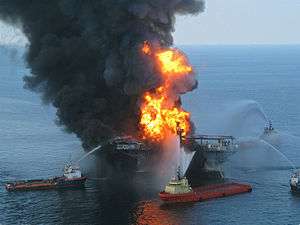United States offshore drilling debate
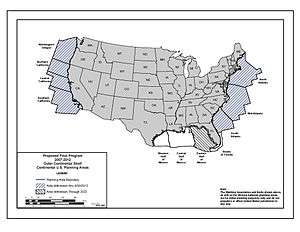
The U.S. offshore drilling debate is an ongoing debate in the United States on whether or not, the extent to which, in which areas, and under what conditions, further offshore drilling should be allowed in U.S.-administered waters.
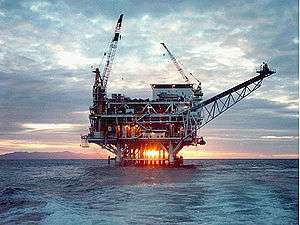
The issue saw increased coverage when President George W. Bush in July 2008 lifted a 1990 executive order by George H. W. Bush banning offshore drilling,[1] while at the same time calling for drilling in the Arctic National Wildlife Refuge.[2]
The issue of offshore drilling became central in the 2008 presidential election, not least because of the oil price increases since 2003. It is also being debated in terms of both environmental issues and U.S. energy independence. As of September 2008, President Barack Obama is for limited offshore drilling as part of an extensive energy independence overhaul.[2]
Bush's energy policy was named "drill and veto" by U.S. House Speaker Nancy Pelosi.[3] The Drill Responsibly in Leased Lands (DRILL) Act (H.R. 6515) is one of the bills discussed in the Congress about drilling.[4] In Florida, many counties, cities, chambers of commerce, and other local agencies have passed resolutions against oil drilling in Florida waters.[5]
On March 31, 2010, President Obama announced that he was opening new areas in U.S. coastal waters to offshore drilling for gas and oil.[6][7] This was in stark contrast to his reaction only a few weeks later to the Deepwater Horizon oil spill in the Gulf of Mexico that has become the largest offshore oil spill in United States history.[8] In November 2010, the Obama administration rescinded the decision to open new areas.[9]
Background
As interpreted by the federal courts, the Commerce Clause of the United States Constitution gives the federal government certain regulatory power over "navigable waters" of the United States. The Submerged Lands Act of 1953 and Continental Shelf Lands Act of 1953, along with the 1960 Supreme Court decision in United States v. States of Louisiana, Texas, Mississippi, Alabama, and Florida, divided ownership of the tidelands of the United States between state and federal governments. States own the sea and seabed out to 3.5 miles (5.6 km), except Texas and Florida which own out to 10.5 miles (16.9 km). The federal government owns the remainder of the territorial waters.
The 28 January 1969 blowout at a Unocal rig, which spilled 3 million US gallons (11,000 m3) of petroleum off the coast of Santa Barbara, California, resulted in drilling bans in offshore California and Florida.[10]
Offshore drilling has continued in offshore Texas and Louisiana. In 2006, an 8,300,000-acre (34,000 km2) area in the Gulf of Mexico known as lease 181 was opened for exploration.[10] The existing moratorium on leasing on the Outer Continental Shelf expired in 2012, and the debate is on whether or not to extend it.
In 2018, a new federal initiative to expand offshore drilling suddenly excluded Florida, but although this would be favored by Floridians, concerns remain about the basis for that apparently arbitrary exception being merely politically motivated and tentative. No scientific, military, or economic basis for the decision was given, provoking continuing public concern in Florida.[11]
Positive Effects of Off-Shore Oil Rigs
Energy independence
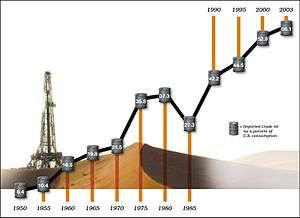
A common argument in favor of offshore drilling is it reduces United States dependency on imported oil. Geopolitically, the U.S. would be less vulnerable to sanctions by oil-producing countries hostile to the United States. It would also make the United States less vulnerable to a stop in a country's oil exports, due to, for example, a civil war or an invasion of that country. The debate often makes references to the 1973 oil crisis and 1979 energy crisis.
Fuel price
One motivation of increased offshore drilling is to reduce the current fuel prices. In 2007, the Energy Information Administration at the U.S. Dep. of Energy analyzed the effect of lifting the ban on oil and gas leasing on the Atlantic and Pacific coasts and the eastern Gulf of Mexico.[12] With leasing beginning in 2012, the agency projected that production of oil would not be expected to start before 2017, and that as a result US oil production by 2030 would be 7% higher than it would be otherwise. The effect on fuel prices, however, would be "insignificant."[13]
The Natural Resources Defense Council estimated that with increased offshore leasing and drilling, the price of oil would only drop about 3–4 cents in 15 to 20 years.[14]
Trade deficit
Oil produced from offshore drilling reduces oil imports, and thus lessens the U.S. trade deficit. From mid-2017 to early 2018, crude oil imports increased from $45 per barrel to $62 per barrel.[15] Given that the trade deficit was already massive before its increase due to increasing oil prices, it is important to consider all options to lower the deficit including expanded national oil production.
Negative Effects of Off-Shore Oil Rigs
Military training
In 2005, U.S. Defense Secretary Donald Rumsfeld stated that offshore drilling would disrupt military training and weapons testing, if done in an area of the Gulf of Mexico along the coast of Florida.[16]
International Relations
Although offshore drilling has long been banned in federal waters off the state of Florida, Cuba has been drilling its own offshore area near Florida.[17] The subject became an issue in the 2008 presidential race, with assertions and denials of the reality of Cuban offshore drilling. On 31 October 2008, Brazilian and Cuban presidents Luiz Inácio Lula da Silva and Raul Castro attended a ceremony at which the Brazilian oil company Petrobras agreed to drill for oil in Cuban offshore waters near Florida.[18] By May 2011 Petrobas had withdrawn from the agreement due to poor prospects.[19]
More recently, Russia has begun drilling in the black sea with a Chinese-made oil rig, Scarabeo 9. Since the rig wasn't built in the U.S. and was agreed to before the imposition of additional sanctions by the E.U. in 2014, Russia has been able to avoid sanctions and operate the rig.[20]
Oil spills
Offshore facilities pose an environmental risk of oil spills. On April 20, 2010, an underwater blowout and subsequent explosion and fire destroyed the Deepwater Horizon rig owned by Transocean Ltd. and operating in the Gulf of Mexico under lease to energy giant BP, resulting in the largest oil spill in United States history. 5 million barrels of oil were spilled into the Gulf of Mexico, leading to $21.5 billion (or $4300 per barrel) of clean-up costs paid by BP.
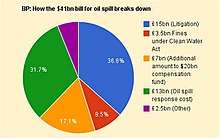
To the right are the costs of the BP oil spill broken down by category. The image doesn't include the $15+ million in tax breaks that BP was able to save. Also, BP has continued to pay out settlements since the graphic was created in 2011 so the orange section in the graph should be larger than it is.
Negative Externalities of Oil Spills
Oil spills create numerous negative externalities that hurt the local and national economy of the place where the oil spill occurred.
- Economy loses money due to decreased production of fisherman: when oil spills occur they lead to the death of many fish in the affected areas. Not only does this affect endangered species and impact the local ecosystem, it also decreases profits of fisherman and thus suppresses the economy. Additionally, the reputation of the fisherman to be able to provide a certain amount and quality of fish is damaged. This further hurts them economically since people won't trust them as much to deliver on their promises and so won't be willing to pay as much for their services. This type of loss is a reputational risk, which is hard to measure but still certainly a negative externality.
- Local businesses lose income from decreased tourism: When an oil spill happens, the waters become dirty and people are less likely to want to vacation in the location where the spill happened. This causes a decrease in profits gained by local businesses due to tourists. Additionally, the place suffers from a decrease in its brand valuation: for example, in the BP oil spill, Florida's reputation for high-quality, natural marine-based resources was tarnished, and so they lost interest from tourists and hotels and local business made less profits than they would have without the oil spill.[21]
- Health costs of cleanup workers in the front line: When an oil spill happens, the company that operates the rig must hire clean up staff to fix the spill. The hazardous conditions that stem from leaking oil are damaging to the workers' health, often causing them to develop respiratory disease and other health complications that can permanently impact their health.
- Costs of wildlife and breeding grounds lost: These also impact tourism, as one of the main reasons people vacation to places with natural resources is to see wildlife. Additionally, throwing off the balance of the ecosystem by disrupting breeding grounds and killing endangered species can have wide-reaching effects economically on the supply of natural resources.[22]
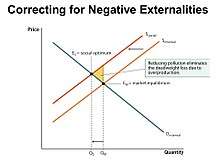
This picture shows how the market can correct for a negative production externality. Once the externality is taken into account, it shifts the producer curve up in the graph, making it more expensive to produce the same amount of the good. The socially optimal quantity is lower than the market quantity, and socially optimal price is higher. By shifting the demand curve up and reaching this new equilibrium, the deadweight loss (the shaded triangle in the graph) can be avoided.
Positive Externalities of Oil Spills
There are some positive externalities that oil spills create, but these are outweighed by the negative externalities.
- Thousands of workers are hired for the cleanup: Though this can damage the workers' health as was previously stated, hiring thousands of workers involves paying them salaries which increases the flow of money into the economy. The workers derive economic benefit from salary that they wouldn't have otherwise had and the economy benefits from their additional spending and consumption.
- Millions of dollars are spent by the party responsible on other necessities, such as products to clean the water, portable toilets, hotel rooms for the clean-up workers, etc. This influx of money into the public economy from a private company is a positive externality of oil spills.[23]
Endangered species
The federal Minerals Management Service gave permission to BP and dozens of other oil companies to drill in the Gulf of Mexico without first getting required permits that assesses threats to endangered species.[24]
In the aftermath of the BP Oil spill, BP was sued by the Defenders of Wildlife and the Southern Environmental Law Center for imperiling 32 threatened or endangered species. These included the sperm whale, gulf sturgeon, manatee and five kinds of sea turtles, in addition to the surrounding water and habitats that were damaged.[25] With every oil spill, endangered species in the area get closer to extinction.
Public opinion
Polls by independent national polling concerns in the US generally show majorities in favor of offshore drilling.
The Pew Research Center, which had documented a large and sharp drop in support for allowing more offshore drilling following the Deepwater Horizon spill in 2010 (down to 44% in favor versus 52% against), found that by March 2012, support for increased offshore drilling had returned to its pre-Deepwater Horizon level, with 65% in favor versus 31% against.[26]
A series of CNN polls 2008-2011 showed that support for increased offshore drilling dropped from 75% before the Deepwater Horizon spill to 57% shortly after. By April 2011, support had increased to 69%, versus 31% opposed.[27]
The Gallup organization found 50% support for increased offshore drilling in May 2010, a month after the Deepwater Horizon explosion. By March 2011, that support had increased to 60% in favor versus 37% opposed.[28]
A more recent study conducted in 2018 by the Pew Research Center found that 51% of Americans now oppose expanded offshore oil rigs versus 42% favoring expanded offshore oil rigs. This represents a 10% decline in those favoring offshore oil rigs since 2014. Generally, people who live within 25 miles of the coastline oppose offshore oil drilling more so than those who live farther from the coast. Also, Democrats oppose additional rig development at a rate of 71%, while only 22% of Democrats favor more offshore oil rigs. On the other hand, 70% of Republicans favor increased offshore drilling in comparison to 25% opposition. Lastly, younger people (aged 18–49) oppose increased offshore drilling at a rate of 58%, compared to only 42% opposition for people aged older than 49. [29]
See also
- Arctic Refuge drilling controversy
- "Drill, baby, drill", a Republican campaign slogan originally used at the 2008 Republican National Convention
- Offshore drilling
- Offshore oil and gas in the United States
- United States oil politics
- Environmental issues in the United States
- Offshore Energy and Jobs Act (H.R. 2231; 113th Congress) - a 2013 proposed bill that would revise policy regarding offshore drilling in the United States
References
- ↑ "Bush lifts executive ban on offshore oil drilling". CNN. 2008-07-14. Retrieved 2008-09-27.
- 1 2 Johanna Neuman; Richard Simon. "Bush 43 urges offshore drilling that Bush 41 banned". Los Angeles Times. Retrieved 2008-09-27.
- ↑ "Pelosi: Bush Administration's Energy Policy is 'Drill and Veto'". United States House of Representatives. Archived from the original on 2008-08-02. Retrieved 2008-09-27.
- ↑ "Congressional Action on Gas Prices & Energy Independence". Nancy Pelosi. Archived from the original on 2008-10-02. Retrieved 2008-09-27.
- ↑ Map of Resolutions Passed Against Offshore Oil Drilling in Florida http://www.google.com/maps/ms?ie=UTF8&hl=en&msa=0&msid=106172446447503097421.000480838fe1fe5d92709&z=6
- ↑ Juliet Eilperin and Anne E. Kornblut (April 1, 2010). "President Obama opens new areas to offshore drilling". The Washington Post.
- ↑ John M. Broder (March 30, 2010). "Obama to Open Offshore Areas to Oil Drilling for First Time". The New York Times.
- ↑ Kristi Keck (May 3, 2010). "Could oil spill sap appetite for Obama's offshore drilling plans?". CNN.
- ↑ John M. Broder and Clifford Krauss (December 1, 2010). "U.S. Halts Plan to Drill in Eastern Gulf". New York Times.
- 1 2 Steven Mufson (2008-07-14). "Offshore Drilling Backed as Remedy for Oil Prices". Washington Post. Retrieved 2008-09-27.
- ↑ Compton, Glenn, 10 Reasons Not to Drill for Oil Offshore of Florida, The Bradenton Times, Sunday, January 14, 2018
- ↑ The Oil Drum. "Presidential Energy Debate Fact Check #1: Is Offshore Drilling the Answer?". The Oil Drum. Retrieved 2010-06-04.
- ↑ "EIA - Impacts of Increased Access to Oil and Natural Gas Resources in the Lower 48 Federal Outer Continental Shelf". Eia.doe.gov. 2003-01-01. Retrieved 2010-06-04.
- ↑ Metropulos, Jim (2008-07-15). "California Knows: Offshore Drilling Doesn't Make 'Cents'". Sierra Club California. Retrieved 2010-12-23.
- ↑ "Oil Price". Business Insider. 2018-03-07. Retrieved 2018-03-07.
- ↑ "Alexander's Gas & Oil Connections - Offshore drilling is incompatible with military missions in Gulf of Mexico". Gasandoil.com. 2005-12-22. Retrieved 2010-06-04.
- ↑ Time (23 October 2008): How Cuba's oil could change the US embargo. Retrieved 17 December 2008.
- ↑ "Petrobras signs with Cuba", World Oil, December 2008, p.109.
- ↑ "Petrobas abandons oil exploration in Cuba". MercoPress. Retrieved 22 March 2014.
- ↑ "Sanctions-Proof Oil Rig Thwarts U.S. Policy From Cuba to Russia". Bloomberg.
- ↑ "Negative Externalities and Oil Spills: A Case for Reduced Brand Value to the State of Florida" (PDF). https://ageconsearch.umn.edu/bitstream/155411/2/jaae453ip2.pdf. External link in
|publisher=(help) - ↑ "LIST OF NEGATIVE AND POSITIVE EXTERNALITIES OF OIL SPILL". Patrick Regoniel.
- ↑ "Negative and Positive Externalities of the Gulf Oil Spill". Patric Regoniel. 2010-06-20.
- ↑ Urbina, Ian (2010-05-13). "U.S. Said to Allow Drilling Without Needed Permits". The New York Times. Retrieved 2010-05-26.
- ↑ "BP TO BE SUED OVER HARM TO ENDANGERED SPECIES". Defenders.org. 2010-05-25.
- ↑ Pew Research Center, As prices pinch, support for oil and gas production grows, 19 Mar. 2012.
- ↑ CNN Opinion Research Corp., , 19 Apr. 2011.
- ↑ Lydia Saad, U.S. Oil drilling gains favor with Americans, Gallup, 14 Mar. 2011.
- ↑ Bradley Jones, UMore Americans oppose than favor increased offshore drilling, Pew Research Center, 15 Jan. 2018.

